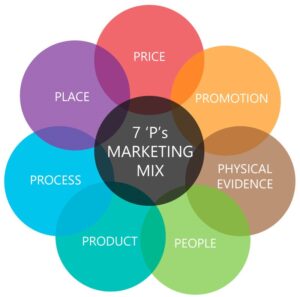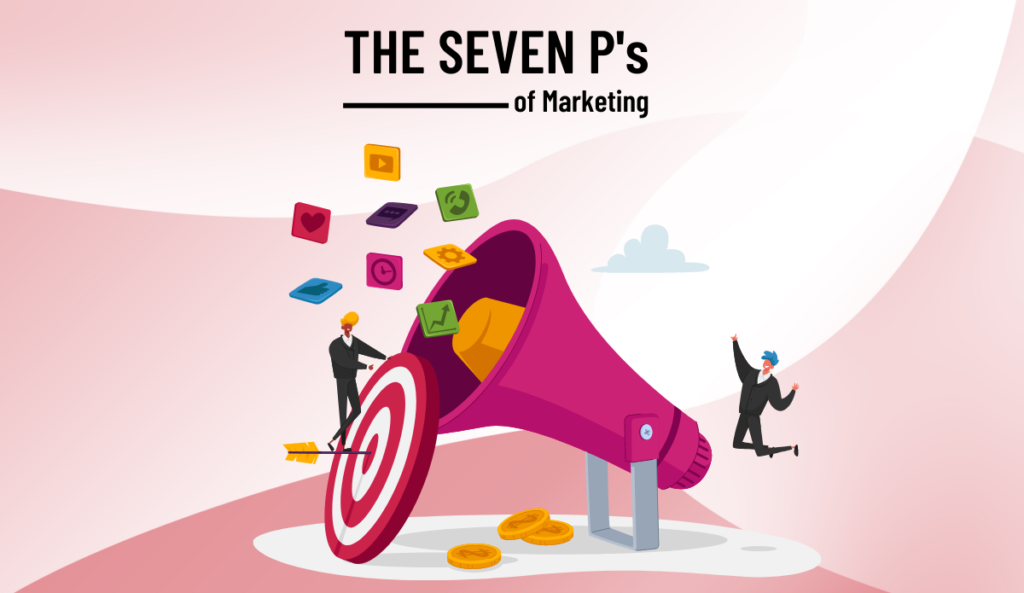Marketing is a very significant component of any successful business.
It involves various strategies and techniques to reach out to customers and persuade them to purchase your product or service. The market
ing mix, commonly known as the “4 Ps of Marketing,” was first introduced by Neil Borden in 1964.
However, as the marketing landscape evolved, the 4 Ps model was updated to include three additional elements, resulting in the “7 Ps of Marketing” framework.
In this blog, we will take a closer look at each of these elements and how they contribute to the overall success of your marketing efforts.

Table of Contents
Place
Place, also known as distribution, refers to the channels through which your product or service is sold and distributed to customers. It can include physical retail locations, online marketplaces, or peer-to-peer networks.
Choosing the right place to sell your product or service is crucial, as it can impact customer accessibility, convenience, and overall experience.
When deciding on the best distribution channels for your product or service, consider factors such as your target audience, the nature of your product or service, and your competitors’ distribution channels.
For example, an online store may be more suitable for a business that sells digital products, while a physical location may be more appropriate for a business that sells physical goods.
In addition to choosing the right distribution channels, it is also essential to ensure that your product or service is readily available to customers. This can include factors such as inventory management, order processing, and delivery logistics.
A seamless distribution process can help ensure customer satisfaction and encourage repeat business.
Process
Process refers to the steps that customers go through when purchasing and consuming your product or service. This can include everything from ordering and delivery to customer support and follow-up. A smooth and efficient process can help ensure customer satisfaction and encourage repeat business, while a confusing or difficult process can result in lost sales and negative reviews.
When designing your customer process, consider the customer journey and identify potential pain points or areas for improvement.
For example, if you sell a physical product, consider how long it takes for the product to arrive at the customer’s doorstep and whether there are opportunities to streamline the delivery process. Similarly, if you offer a service, consider how easy it is for customers to book appointments or access support.
People
People refer to the individuals involved in delivering your product or service to customers. This can include management, customer service representatives, and employees. Having knowledgeable and friendly staff can help create a positive customer experience and build brand loyalty.
When hiring and training your staff, consider the importance of customer service skills, product knowledge, and overall professionalism. Additionally, it is essential to ensure that your staff understands and embodies your brand values and messaging.
In addition to the individuals involved in delivering your product or service, it is also crucial to consider your target audience and their needs. Understanding your audience can help you tailor your messaging and customer experience to meet their expectations.
Promotion
Promotion refers to the methods used to advertise and promote your product or service. This can include advertising, offers, free trials, and other marketing campaigns.
Effective promotion can help generate awareness and interest in your product or service, leading to increased sales and revenue.
When developing your promotional strategy, consider your target audience, budget, and overall marketing goals. For example, if you are targeting a younger demographic, social media advertising may be more effective than traditional print or television ads.
Additionally, consider the effectiveness of different promotional tactics, such as email marketing, influencer partnerships, and event sponsorships.
Physical Environment
.
The physical environment refers to the facilities and surroundings in which your product or service is delivered. This can include the comfort and cleanliness of a physical location or the user interface of an online platform. A pleasant and comfortable environment can help create a positive customer experience and increase customer satisfaction, while a poor environment can have the opposite effect.
When designing your physical environment, consider the needs and preferences of your target audience.
For example, if you run a restaurant, consider factors such as lighting, seating, and décor to create a welcoming and comfortable atmosphere. Similarly, if you operate an online platform, ensure that the user interface is intuitive and easy to navigate.
Price
Price refers to the cost of your product or service and is a crucial element of the marketing mix. Setting the right price can impact customer perceptions of your product or service and ultimately determine your profitability.
When determining your pricing strategy, consider factors such as your production costs, competition, and customer demand.
There are several pricing strategies and techniques that businesses should use, including cost-plus pricing, dynamic pricing, and value-based pricing. Cost-plus pricing involves adding a markup to the cost of production to determine the final price.
Dynamic pricing involves adjusting prices based on changes in demand or supply. Value-based pricing, on the other hand, involves setting prices based on the perceived value of the product or service to the customer.
Ultimately, the right pricing strategy will depend on your business goals and the needs and preferences of your target audience.
Product
The final element of the marketing mix is the product itself. This includes the value, branding, and packaging of your product or service. Developing a high-quality product that meets the needs and preferences of your target audience is essential for success.
When developing your product or service, consider factors such as functionality, design, and overall quality. Additionally, consider the branding and packaging of your product, as these elements can impact customer perceptions of your brand.
Final Words
In conclusion, the 7 Ps of Marketing provides a comprehensive framework for businesses to develop effective marketing strategies. By considering each of these elements and tailoring your approach to the needs and preferences of your target audience, you can increase brand awareness, generate sales, and ultimately achieve business success.


